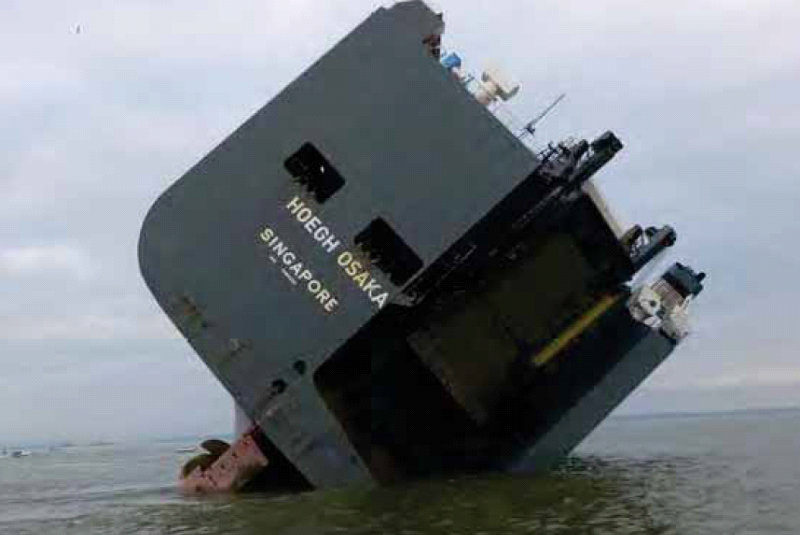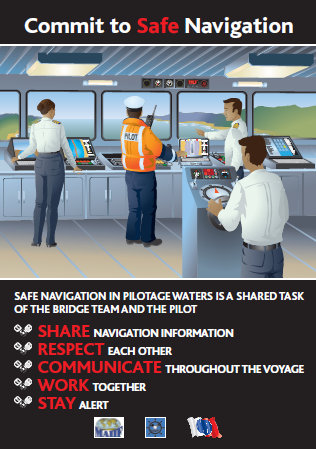Inadequate Stability – Undesirable consequences
What Happened?
After departing the berth, while under pilotage, a pure car and truck carrier developed a significant starboard list causing some cargo shift and subsequent flooding. List in excess of 40° caused the ship to lose steerage and propulsion as she drifted onto shallow waters. All crew and the pilot were safely evacuated from the stricken vessel and surrounding waters. While there were no pollution and major injuries, a massive salvage operation which lasted more than 2 weeks was undertaken before she was subsequently towed to a berth.

Source : MAIB,UK
A detailed investigation was conducted by the Marine Accident Investigation Branch, UK (MAIB), on the events that led to the serious casualty. The objective of the investigation was not to determine liability but rather, to prevent recurrence. A number of safety issues were identified in the investigation report and where appropriate, safety recommendations for the operators of the vessel and for the benefit of the PCTC industry, in general, were issued. MPA participated in the investigation as a Substantially Interested State and concurred with the report.
Why Did It Happen?
Investigations revealed that on completion of loading, the vessel departed with positive but inadequate stability, which was marginally below the minimum stability criteria set out by the IMO. Also, no calculations reflective of the actual stability condition had been done prior to the vessel’s departure. Cargo distribution was such that the upper car decks of the vessel were full while the lower decks were lightly loaded. Given that she was low on bunker fuel, the overall vertical center of gravity (VCG) of the vessel was very high.
Investigations identified that the crew on board had not taken the following into consideration, amongst others, in the assessment of the stability of the vessel –
- Change in port rotation a few days prior to her loading
- Actual status of the ballast on board. Assumptions had been made without physical verification of the ballast tanks in the absence of working ballast gauges
- Investigating the reason for the difference in calculated draughts VS observed draughts
- Status of bunkers on board considering the change in port rotation
Investigations also revealed that the planning and execution of the pre-loading plan were not properly communicated between the port captain, as the charterer’s representative, and the crew on board. This was due to the change in itinerary of the vessel.
In addition, it was found that there were significant differences between the actual weight and the shipper’s declared weight for several cargo units that had been loaded on board. Investigators found that some high and heavy cargo units may not have been secured as per the cargo securing manual onboard and that there was a lack of clearly marked securing/lashing points on some cargo units. This was a violation of the requirements of the IMO’s Code of Safe Practice for Cargo Stowage and Securing (CSS Code).
Intent and Purpose
- A safety flyer issued by the MAIB suggested, through witness, anecdotal evidence and the findings of other investigations, that it is a general practice in the car carrier industry for ships to sail before an accurate departure stability condition has been calculated, on the assumption that their stability condition is safe
- The purpose of this article is to raise the awareness of the shipping industry in ensuring adequate stability prior to departing the berth so that vessel meets the minimum stability criteria for the voyage
Safety Recommendations
- Shipmasters and officers should ensure their vessel does not depart the berth unless they are satisfied that the vessel meets the stability criteria for the intended voyage by a safe margin
- It is recommended that shipping companies read and review MAIB’s investigation report to assess and, where necessary, revisit their respective Safety Management System(s) to mitigate the risks involved due to identified gaps.
MAIB’s full report can be accessed from the following link –
Safe Navigation in Pilotage Waters
Investigations into incidents in pilotage waters have shown that inadequacies in the operational relationship between marine pilots and ship masters/watch-keeping officers are associated with safety deficiencies with the teamwork on the bridge, including communication between marine pilots and masters/officers/other members of the watch.

A joint education project by the Marine Accident Investigators International Forum (MAIIF) and the International Maritime Pilot’s Association (IMPA) has been conducted to address this concern.
A poster has been produced to emphasise the importance of the bridge team in developing a shared mental model of how the passage will unfold. This is to maintain adequate communication throughout the passage and to ensure that individuals in the team monitor the progress of the ship’s manoeuvers from the different vantage points so as to reduce the possibility of a single point failure.
To date, about 500 posters have been distributed to our stakeholders. This includes shipping companies operating or owning Singapore registered ships, pilotage service providers and approved training service providers conducting Bridge Team and Resource Management courses.
Soft copies of the poster can be obtained from MPA, Singapore by writing in to Ship Investigation Department at ivd@mpa.gov.sg
